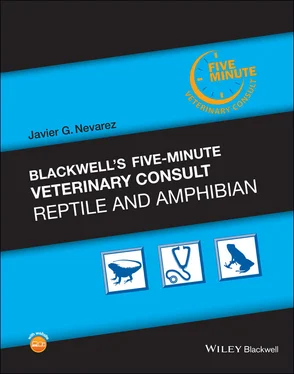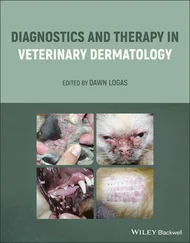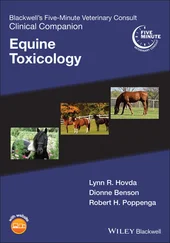Morphine: 1–10 mg/kg IM, SC q24h
Hydromorphone: 0.2–0.5 mg/kg IM, SC q12–24h
Morphine and hydromorphone can cause sedation and respiratory depression.
Dose and frequency of administration should be refined based on the patient’s response.
 FOLLOW‐UP
FOLLOW‐UP
PATIENT MONITORING
If performing medical therapy alone, the weight of the chelonian should be recorded daily to every other day to provide an early indication that follicle atresia may be occurring.
Any acute weight losses beyond 10% of the body weight should prompt re‐evaluation by a veterinarian.
If an underlying disease process was diagnosed, appropriate follow‐up diagnostics should be performed to determine improvement of that condition or the need to alter therapy.
For those undergoing surgery, a re‐evaluation with 1–2 weeks is recommended to evaluate the surgical site and overall recovery.
EXPECTED COURSE AND PROGNOSIS
Ultimately, the prognosis will depend on the underlying cause of follicular stasis and the required therapy.
Cases with underlying infectious or metabolic disease that respond to medical therapy have a good prognosis.
Many cases requiring surgical therapy have a good to guarded prognosis.
 MISCELLANEOUS
MISCELLANEOUS
COMMENTS
The ultimate diagnosis of follicular stasis is based on interpretation of clinical signs, history, and results of physical exam and diagnostics.
Before ovariectomy is performed, it is essential to have at least one confirmatory test that there are indeed follicles present in the coelomic cavity.
It must be mentioned that the sex of the animals must be confirmed as female before surgery is performed.
While this may seem obvious, in some chelonians species sex determination can be quite challenging, especially when of small size, and males may present with coelomic neoplasias or GI obstructions that clinically appear very similar to follicular stasis.
N/A
Preovulatory follicular stasis
Ca = calcium
CBC = complete blood count
CT scan = computed tomography
GI = gastrointestinal
IM = intramuscular
Mg = magnesium
MRI = magnetic resonance imaging
NSHP = nutritional secondary hyperparathyroidism
P = phosphorus
PO = per os
SC = subcutaneous
UVB = ultraviolet B
1 Chitty J, Raftery A. Follicular stasis. In: Chitty J, Raftery A, eds. Essentials of tortoise medicine and surgery. Oxford, UK: Wiley Blackwell; 2003:200–204.
2 Jacobson ER. Overview of reptile biology, anatomy, and histology. In: Jacobson ER, ed. Infectious Diseases and Pathology of Reptiles: Color Atlas and Text. Boca Raton, FL: CRC Press; 2007:14–17.
3 McArthur S. Problem‐solving approach to common diseases of terrestrial and semiaquatic chelonians. In: McArthur S, Wilkinson R, Meyer J, eds. Medicine and Surgery of Tortoises and Turtles. Ames, IA: Blackwell; 2004:309–378.
AuthorJavier G. Nevarez, DVM, PhD, DACZM, DECZM (Herpetology)
Gout
 BASICS
BASICS
DEFINITION/OVERVIEW
Gout is a common disease seen in reptiles, which occurs due to the buildup of uric acid crystals deposited in or around the joints or throughout visceral organs.
Increased production of uric acid may occur due to excessive levels of dietary proteins, or potentially due to an inherited enzyme defect as occurs in humans.
Excretion may be compromised, for example by dehydration, starvation, nephrotoxic drugs, or renal pathology.
Uric acid is a relatively insoluble substance so when levels are elevated in the blood or in other body fluids, crystallization will occur and deposits will form.
Uric acid crystals may deposit in the joints (articular gout), around the joints (periarticular gout) or throughout other internal organs (visceral gout).
Common sites for visceral gout include the kidneys, liver, spleen, pericardial sac, lungs, and subcutaneous tissue.
More common in terrestrial species with a history of husbandry or diet deficits.
Sometimes may have been previously treated with potentially nephrotoxic drugs.
Animals with articular or periarticular gout usually present with obvious joint swellings.
One or more joints may be affected, and the animal may be lame.
Animals with visceral gout may be asymptomatic or may have non‐specific signs such as lethargy and reduced appetite.
Sometimes white nodules may be visualized on examination of the oral cavity or subcutaneously.
Inappropriate environmental temperatures
Inappropriate water provision (e.g., low humidity or fresh water not supplied in an easily accessible way)
High‐protein diets
Administration of potentially nephrotoxic drugs (e.g., aminoglycosides), especially to dehydrated patients.
 DIAGNOSIS
DIAGNOSIS
Gout may be suspected on history and clinical examination, but diagnostic testing will be necessary for definitive diagnosis.
For articular swellings, differentials include pseudogout, septic arthritis, trauma, and metabolic bone diseases.
Cytologic examination of aspirates from affected joints for articular or periarticular gout. For visceral gout, biopsies need to be taken for histopathology.
Demonstration of uric acid (usually monosodium urate) crystals is necessary for definitive diagnosis.
Blood uric acid levels may be elevated, but this is not always a consistent finding as this depends on the stage in the disease process.
On radiography of affected limbs, lytic lesions may be seen in and around joints. Crystals are radiolucent so will not be detected.
Ultrasound of the coelomic organs may reveal echodense areas of precipitates within internal organs in cases of visceral gout.
On gross postmortem examination, small white nodules (tophi) can be seen scattered throughout visceral organs, within or around joints.
On histopathological examination, tophi are often surrounded by granulomatous inflammation.
 TREATMENT
TREATMENT
APPROPRIATE HEALTH CARE
Treatment aims to lower blood uric acid levels and promote uric acid excretion.
Читать дальше

 FOLLOW‐UP
FOLLOW‐UP MISCELLANEOUS
MISCELLANEOUS BASICS
BASICS DIAGNOSIS
DIAGNOSIS TREATMENT
TREATMENT










